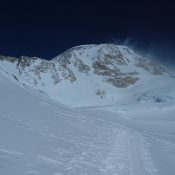
In 2009, I joined with John Platt, his brother Tom and Tom Martin to attempt Denali. At the time I only knew John and not very well. After 2 unsuccessful attempts on the mountain (1985 and 1987), I was hopeful that this group would make a strong team with the endurance to successfully make the summit. On paper, it was a strong team. My 3 companions were all formerly high-level, successful bicycle racers in great shape. Denali can humble even the strongest climbers. To be successful you need desire, patience, staying power and a bit of luck with the weather. Finding climbers willing to commit to an expedition is often a stumbling block that is impossible to overcome. In this instance, putting a team together was easy. The following discussion, some written before the trip and some after, tells the story.
Topics
Pre-Trip Discussion.
Post-Trip Reflections and Photos.
Training.
Equipment.
PRE-TRIP DISCUSSION
Here I go again! Denali? Am I crazy? I am 57 and I have not been on a major glacier climb since 2001 or climbed in Alaska since climbing in the Saint Elias Range in 1992. But I have never stopped climbing or lost my desire to climb. But Denali? I attempted the peak in 1985 and 1987. Both trips were great adventures but ended short of the summit.
The weather knocked the 1985 team out of contention. The entire approach was dogged by snowstorms which kept the team pinned down for days on the lower glacier. After arriving at our 14,300-foot advanced base camp (the last staging area before the summit push), we were anxious to push on. We carried loads to 16,400 feet in good weather. The next day we moved up to the 17,200-foot camp in good weather. The next day, a storm came in and pinned us down for 4 long days. The wind and ground blizzard raged for too long and sucked our physical and mental strength. When the storm subsided momentarily, our food and fuel were depleted and we abandoned the climb. It was a good decision as we only had a 12-hour break before the storm picked up. When we returned to our 11,000-foot cache (which was marked by an 8-foot wand), only six inches of the wand were visible above the new snow level.
In retrospect, the 1987 climb was doomed from the beginning. I was the only climber not living in Moscow (ID) and the leader (an extremely competent climber) evidently took a hands-off approach to managing the planning aspects of the climb. Poor planning of the food requirements, too many climbers on the team and several inexperienced climbers were the primary elements that doomed the climb. The food planners mostly brought food directly off grocery store shelves like boxed spaghetti dinners and similar meals which they did not even bother to repack. The food was difficult to prepare in cold, snowy conditions and, worst of all, there was not nearly enough food. In my climbing log, I noted on the 2nd day of trip that the food situation would likely keep us from making the summit.
Snowstorms and blizzard conditions slowed us down as we moved up the glacier but we pushed on. I will say that, for the first 10 days, everyone was enthusiastic and the team was spirited. After 10 days, we made it to 14,000 feet. We were pinned down by the weather for 2 days. On June 2nd, we carried loads to 16,800 feet. The carry wiped out most of the team and we had to take June 3rd as a rest day. I noted we only had 6 days of inadequate food left. On June 4th, we moved camp up to 17,200 feet. It was the best day of the entire trip. It should have been our summit day. The next day, we woke up to deteriorating weather but started out for the summit with 3 rope teams.
The expedition leader was sick and stayed in camp. At Denali Pass, the wind was exceeding 50MPH. 2 rope teams turned around without consultation of the 3rd team (my team). My rope had the 3 most experienced climbers and we started up from the pass but at around 18,000 feet, we surrendered to the wind and turned around. It was a good decision as the wind was creating ground blizzard conditions and was probably blowing a lot harder 2,000 feet above the pass. The next day, I took 3 sick climbers down to the 14,300-foot camp as the weather continued to deteriorate. The rest of the team came down the next day. We were out of food and we were done.
So why, at 57 years old, go at it again? Was I suffering from a “Mid-life crisis?” At 57, I am probably past mid-life anyway. Crazy? One friend asked, “Don’t ya think you’ve done enough? There are no answers to these questions. I climb because I enjoy it. The idea of returning to Denali first came to me in early 2008 when reading about a Winter climbing trip on Dan Robbins’ Idaho Summits bulletin board. I raised the idea with Dan and with John Platt. Both are rabid peakbaggers. While interested, Dan could not consider it due to job and family commitments. John was all ears. John and I skiied together on a weekday soon after and discussed the idea with some enthusiasm. However, shortly thereafter, I started having medical symptoms which were eventually diagnosed as prostate cancer. Due to the symptoms and lack of time to prepare, I gave up on the idea for 2008.
The lure of Denali never left my mind. In August, Laurie and I did a long, hard backpack trip in the Sierra Nevada Mountains and I did well carrying a heavy pack, which is a skill of absolute necessity for Denali. But I still had to undergo radiation treatment before I could really think about Denali again. The treatment ran from mid-August until late October. I was slowed by the side effects of the treatment but kept riding my bike and even did a little hiking, including the climb of a 10,000-foot peak on my birthday. On the first of November (a week after the treatments ended), I was on a climb with John, his brother Tom and Michael Pelton. The upper peak was covered with snow. After moving across the steep slopes and climbing a short chimney, I knew in my heart that Denali was back on the table.
Soon after the climb, John and I were exchanging e-mails about a possible trip. I did my best to point out that the trip would involve 3-4 weeks of suffering with no guarantee of success. John and Tom came over at Christmas break to look at my Denali slides. I also showed them my South American climbing slides to show them you could climb big glacier-covered peaks in good weather. The more I tried to dissuade them, the more committed they became. We set a date of January 15th to make a commitment. However, I knew when they left my house that I was going to go and I suspected they had already decided to go.
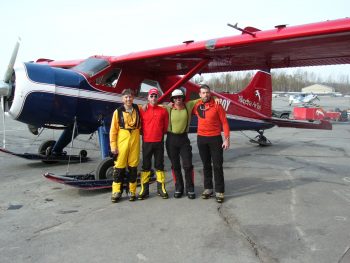
Team building is often overlooked in planning for a Denali expedition. Our team had 4 different agendas and time tables which was not a recipe for success.
John signed up his friend Tom Martin as our 4th climber and, by January 15th, we were already well into planning the trip. Most of my expedition equipment had remained unused in the basement for the last 10 years, including my sled and boots. Gear technology has improved a great deal in the last 20 years. I immediately decided to take advantage of new boot technology and also to upgrade my down coat and gloves. There is nothing that gets me more excited about a major climb than buying more equipment.
As of April 28th, I got a clean prognosis from my doctor and the “Tom Tom Club” (John’s name for our group) was ready to go.
POST-TRIP REFLECTIONS
We were on Denali from May 10th-May 19th. We left with 15 days of unused food.
“Everyone wants to go to heaven but no one wants to die.”
This lyric from an old blues song is an appropriate summation of the 2009 effort. It’s a long way from the landing strip on the Southeast Fork of the Kahiltna Glacier to the summit and the distance is not measured in just miles. The 2009 attempt was unsuccessful, disappointing and an object lesson in how climbing teams must have equal levels of commitment. Our team failed the commitment test. Although I am now 0 for 3 on this big peak, I once again established that I can still endure hardship and that I still have the tolerance for misery. Climbing Denali is all about commitment, endurance, patience and a tolerance for suffering. If you do not have all 4 qualities, don’t go.
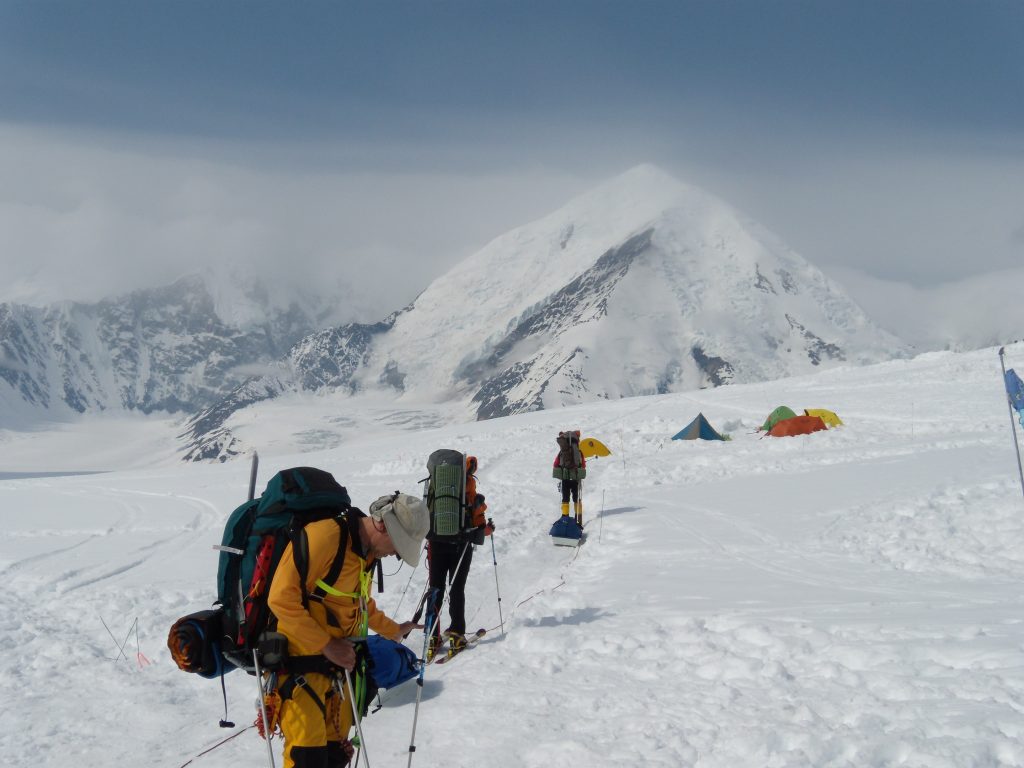
Distances are measured in hours on Denali.
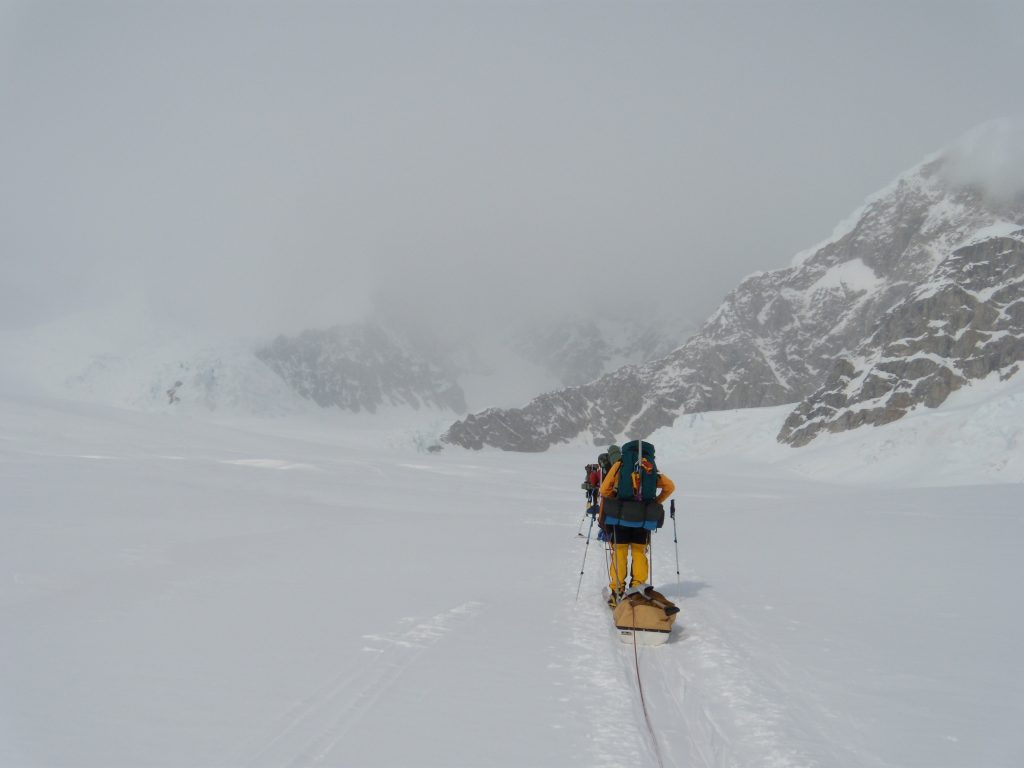
Only the weather has complete control on the mountain.
All 4 of us were in good shape and did well physically. Physical conditioning was not the problem. Our age (a combined 204 years) was not a factor in our defeat. We passed other rope teams of younger climbers on several occasions and I can only remember one rope team overtaking us. We all adjusted to the altitude. The planning effort was, if anything, too successful. We lacked for nothing and instead had too much food–which is not a bad thing.
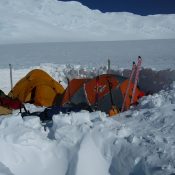
Everything you do on the mountain takes extra effort, from building camp to melting water to sleeping.
We arrived at 14,200 feet on the 7th day, which was 3 days faster than my best time on earlier trips. We had 8 days of food and lots of fuel either at the 14,300-foot advanced base camp in Genet Basin or in a food cache 30 minutes below camp near Windy Corner.
After a bit of discussion, we decided to make an attempt on the summit from 14,300 feet. The thinking was that if we were moving fast enough, we could make it with light packs and if we did not move fast enough, the effort would help us acclimatize. One rule of thumb is to climb high and sleep low. We had a beautiful day and climbed to 17,200 feet in 5.5 hours. I thought that we climbed strongly. Clearly, we were faster than many groups as we worked up the headwall and the fixed ropes. I don’t think that any of us thought we could make the summit on the first try because we had only spent one day at 14,000 feet. Still, we climbed up and down the most treacherous part of the route. I thought it was a victory.
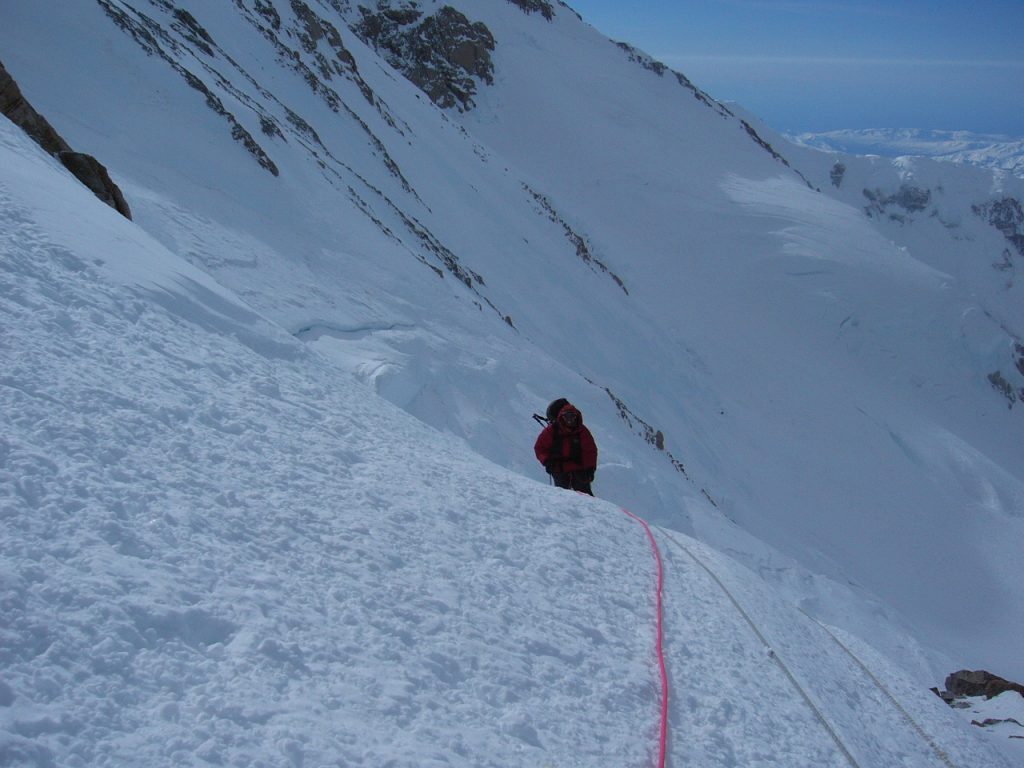
The last few steps up the headwall.

In the way, rocks–a major obstacle on top of the West Buttress.


Our high point, the 17,400-foot high camp, is one step up the ridge. Denali (right) and the North Summit (left). So close but not enough desire as a team to finish the climb.
Back at base camp, we digested a weather report that said a weak weather system would impact the mountain over the next 3 days. It did not sound serious to me and our location was the perfect spot to wait out a storm. However, my 3 teammates made the decision to abandon the climb based on the weather report. I was flabbergasted and angry. We had over half of our food left and plenty of fuel–enough for another 12 days. Nothing I said could change their minds. So, on the threshold of success, we skiied out the next day. In fact, they were so ready to leave that we skiied out all the way down to Kahiltna Base in one day.

Carrying full loads and pulling a sled up Ski Hill was a mistake that had results. My heals blistered and my bindings failed. Misery to overcome.
During the climb, there was clearly disagreement over those who wanted to power up the mountain with single carries of all of our equipment and me. I counsel that we carry high, sleep low, leap frogging our way up the mountain. I also thought that we should take an extra 1-2 days getting to Genet Basin as you cannot underestimate the value of better acclimatization. While I do not believe that the 2 full carry days (from the landing strip to 7,800 feet and up Ski Hill) adversely affected our conditioning, it clearly increased the suffering associated with the lower glacier slog. Pulling that weight up Ski Hill caused me to develop bad blisters on both of my heels and forced me to stay in camp for a day.
We had great weather. In 13 days, we had only a couple inches of snow. In 1985, I experienced several feet of snow on several different days. We had some wind but it was all below 40 mph and we had a lot of windless time on the mountain. As someone commented, “A 40 mile-an-hour wind is a mere breeze on Denali.”
My climbing partners were all strong climbers capable of pulling big loads and working as a team. All of them are stronger than I am. Tom Martin in particular is stronger than a mule and always pulled the biggest load. Tom Platt, although the smallest team member, proved he could constantly pull heavy loads and keep going. My teammates also trained hard and, as bicycle racers, they had pushed themselves through walls of pain unknown to most humans. John Platt did a great job of organizing the trip. He is a good-natured and component climber. None of this was enough. After 12 days, they were ready to go.
TRAINING
A few words about training. In 1985, running was my main training exercise. From January 1st until we left, I ran 402 miles. I also got in 20 miles of cross-country skiing and a 18-mile backpack in March. In mid-April, the team made a successful training ascent of Mount Hood. In 1987, I ran more than 534 miles from the first of January until leaving for Alaska. Many of the runs were in the Boise foothills. The longest run was 12 miles. I also added 40 miles of cross-country skiing and 20 miles of hiking. I was probably in the best shape of my life for the 1987 trip.
I know that it is physically impossible to be as strong at 57 as I was at 36. Still, the goal is to get as close as possible. I no longer run and instead I relied on bike riding for my main cardiovascular training. Since it is at least a 500-foot climb to get up the hill to my house, it is good training. I have supplemented my bike riding with hiking, XC skiing, weight lifting and yoga. I want to avoid burnout so I envision my training to peak about 2 weeks before we left. I believe that the weight training and yoga were as important as the cardiovascular training.
Perhaps nothing is more important than having a positive mental attitude when approaching a peak like Denali. In this respect, I feel like I was well above my teammates. I have much more climbing experience now than I did in the mid-80s and I knew what to expect on Denali. I knew I could hang out in a tent for days waiting for good weather. Many people do not have this ability.
As of April 30th, I rode my bike, hiked or backcountry skied 1,002 miles, made 12 ascents of peaks in the Boise area and totaled about 65,000 feet of elevation gain (a nearly even split between hiking and bike riding). If you think this sounds impressive, keep in mind that Tom Platt rode a bike 500+ miles in one week this Spring and John climbed more peaks than I did and carried a 70-pound pack to the top on many of his climbs. Still, I am satisfied with my effort, which was designed to toughen me to midsummer conditioning before departure.
DENALI 2009 EQUIPMENT
SLEEPING GEAR
1) NF Inferno/compression stuff sack
2) Bivy bag
3) Vapor Barrier liner
4) Thermarest Pad
5) Blue Pad
6) VE 25 with extra poles, extra cord, ripstop tape.
Weight 19.5 pounds
SKI EQUIPMENT
1) Downhill Skis
2) Poles
3) Skins
4) Repair Kit (Skis, crampons, stove, include sewing kit)
Weight 11.0 pounds
FOOTWEAR
1) Spantik Boots
2) Overboots
3) Crampons
4) 3 pairs liner socks
5) 3 pair wool socks
6) Vapor barrier socks
7) Small container of foot powder
8) Down booties
Weight 9.0 pounds
HEAD AND HANDS
1) Expedition mitts
2) Expedition gloves
3) Chemical handwarmers (4)
4) Light gloves
5) Medium gloves
6) OR hat
7) Face mask
8) Goggles
9) Glacier sunglasses
Weight 5.0 pounds
CLIMBING GEAR
1) Ice axe and picket
2) Climbing harness
3) 6 carabiners (2 locking)
4) Jumars with prusick slings
5) 3 additional slings
6) Rope
Weight 10.5 pounds
OUTERWEAR
1) NF Parka and bibs
2) MH down coat
3) Pile bigs
4) Blue pile jacket or blue REI jacket
5) Lightweight polypro
6) Heavy polypro
7) 3 pairs underpants (polypro)
Weight 8.0 pounds
COOKWEAR
1) 2-quart pan
2) REI insulated cup and measuring cup
3) Large plastic spoon
4) 2 water bottles and insulated bags/duct tape
Weight 3.5 pounds
FIRST AID
1) Suntan lotion and lip cream
2) Toothbrush and paste
3) Moleskin
4) Band aids
5) Medicine (lomotil, air sickness pills, Sudafed, 100 Ibuprofens, 3 rolls of Tums, vitamins, eye goop, tinactin)
Weight 2.0 pounds
MISCELLANEOUS
1) Earplugs
2) Paperback books
3) Camera
4) Paper and pencil
5) Map and route information
6) Ipod and solar charger
7) Shovel
8) Picket
9) Toilet paper
Weight 8.0 pounds
PACK AND SLED
1) Mountainsmith sled–add back loop for carabiner
2) Dana design or Kelty pack
3) 2 compression stuff sacks
Weight 20.5 pounds
Total weight minus food: 96.5 pounds
Next: Line of No Return: Evolution Basin